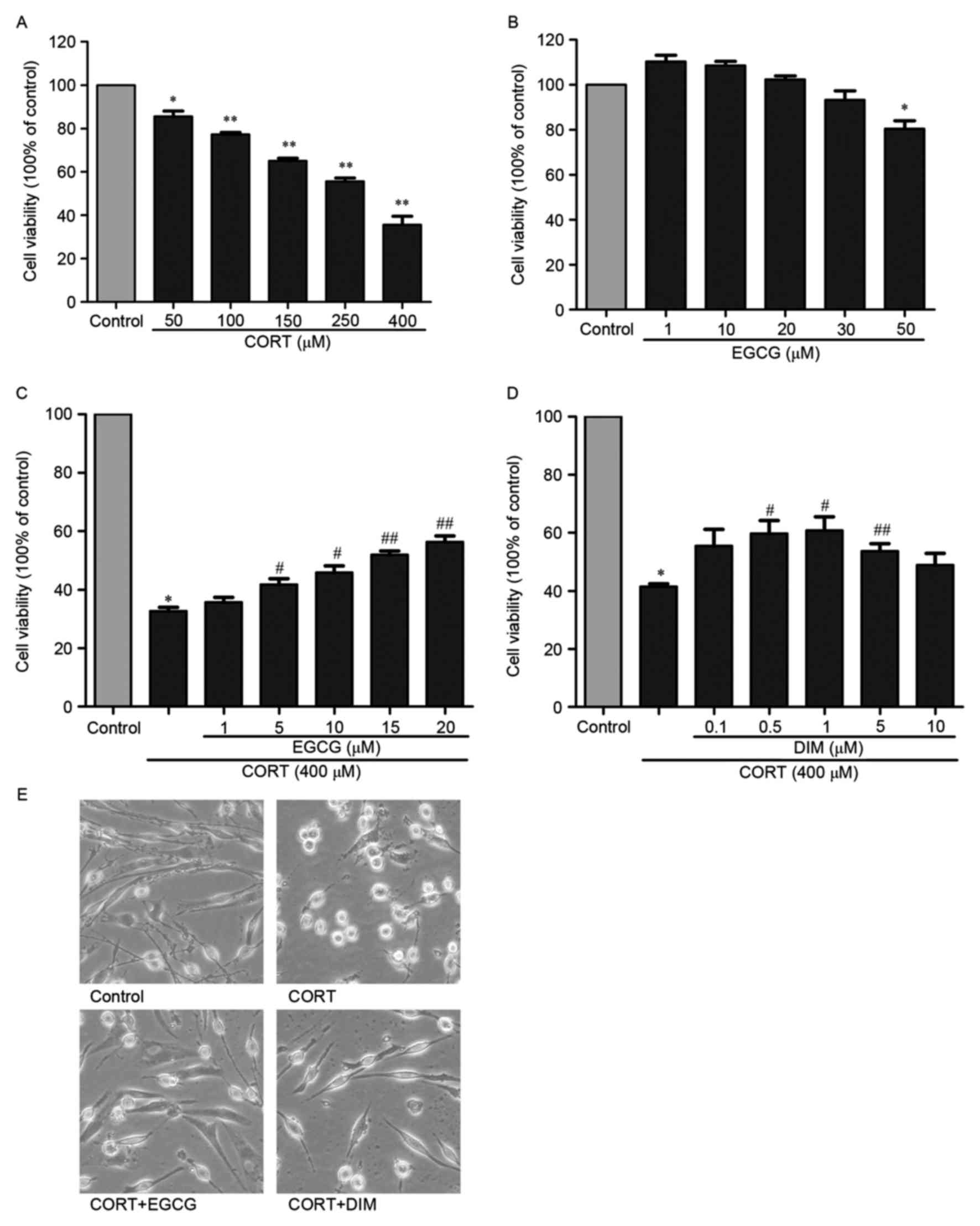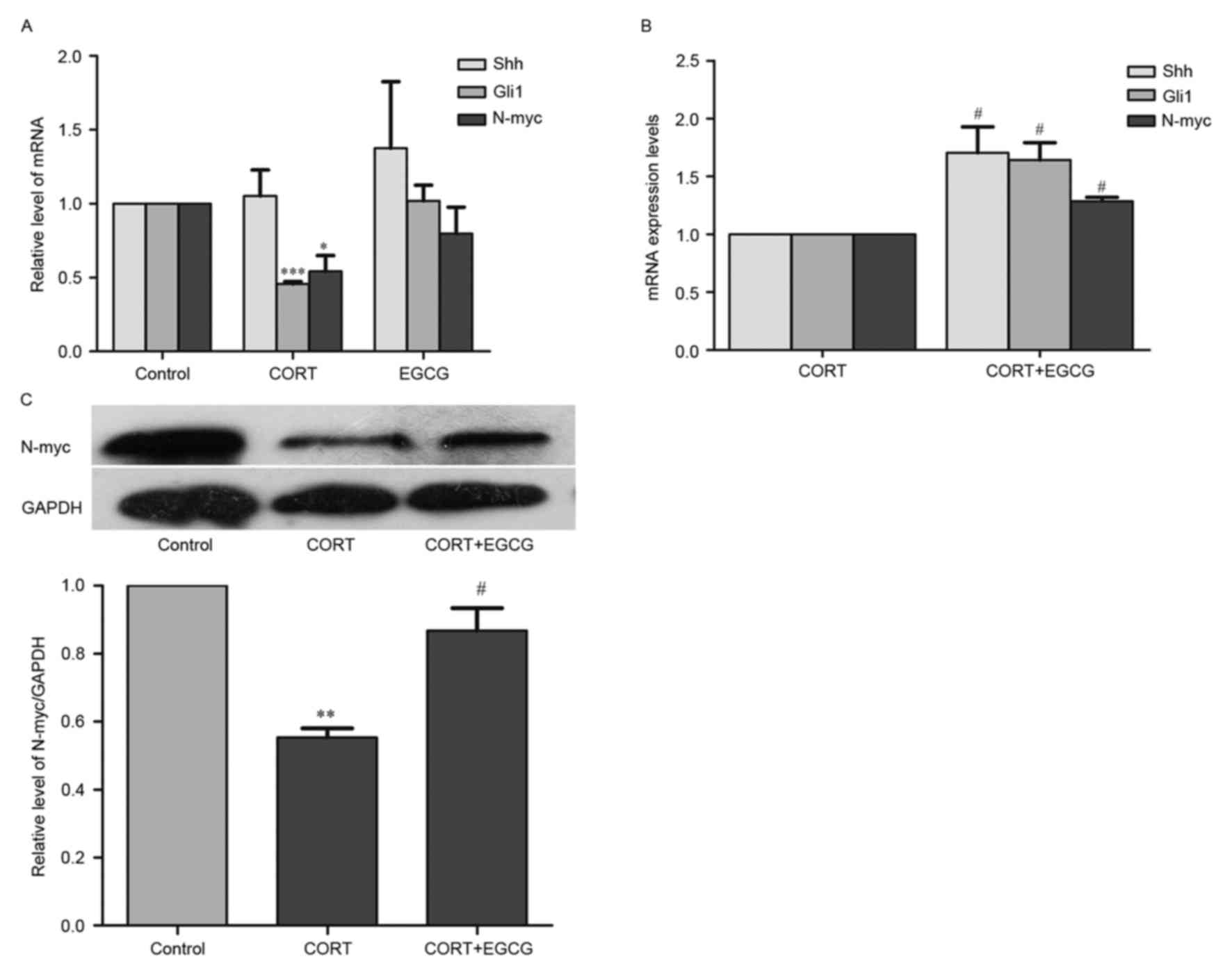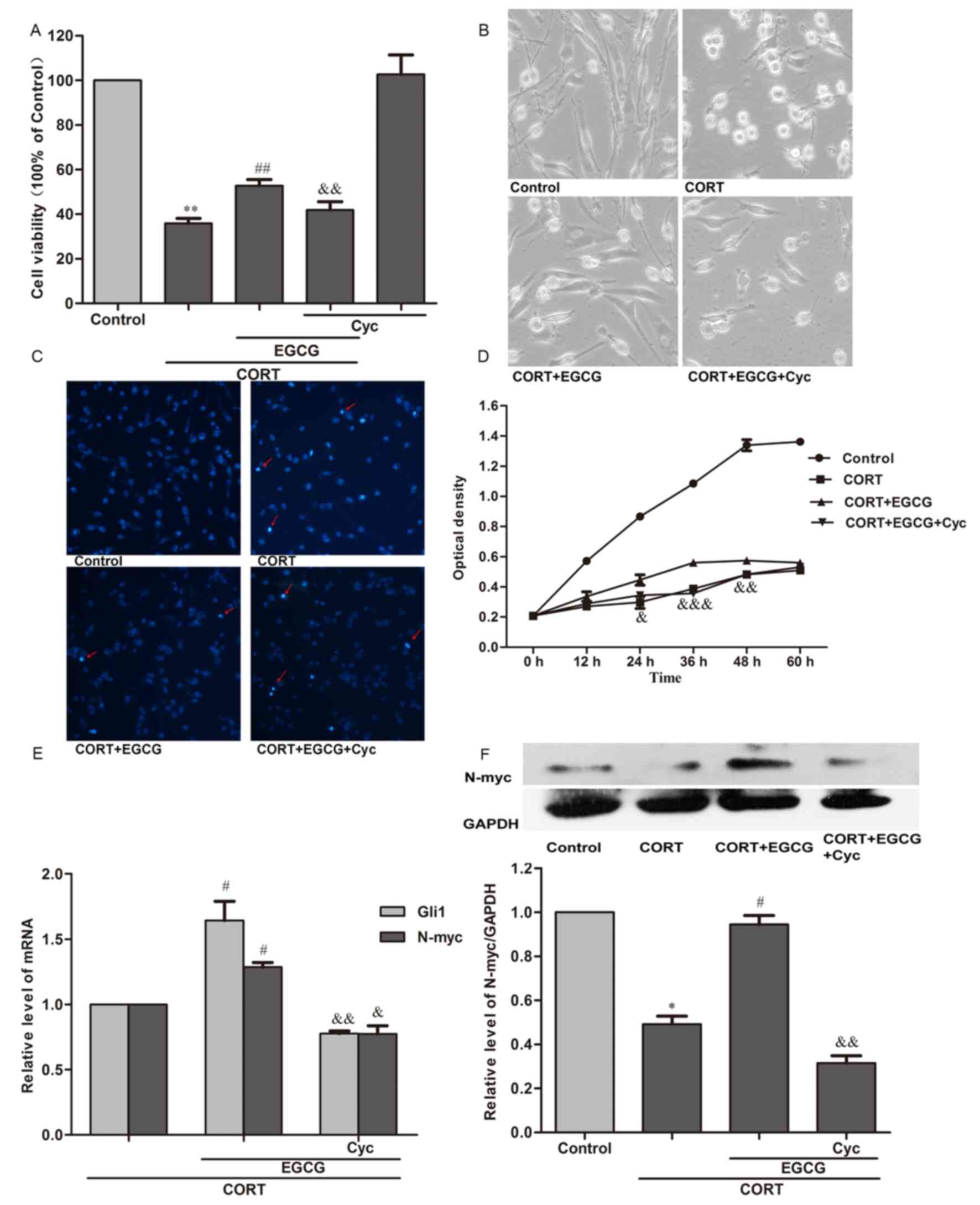|
1
|
Spielmans GI, Berman MI, Linardatos E,
Rosenlicht NZ, Perry A and Tsai AC: Adjunctive atypical
antipsychotic treatment for major depressive disorder: A
meta-analysis of depression, quality of life, and safety outcomes.
PLoS Med. 10:e10014032013. View Article : Google Scholar : PubMed/NCBI
|
|
2
|
Watson S, Gallagher P, Del-Estal D, Hearn
A, Ferrier IN and Young AH: Hypothalamic-pituitary-adrenal axis
function in patients with chronic depression. Psychol Med.
32:1021–1028. 2002. View Article : Google Scholar : PubMed/NCBI
|
|
3
|
Zhao J, Peng L, Zheng W, Wang R, Zhang L,
Yang J and Chen H: Chemically bonding of amantadine with
gardenamide a enhances the neuroprotective effects against
corticosterone-induced insults in PC12 cells. Int J Mol Sci.
16:22795–22810. 2015. View Article : Google Scholar : PubMed/NCBI
|
|
4
|
Li YF, Liu YQ, Huang WC and Luo ZP:
Cytoprotective effect is one of common action pathways for
antidepressants. Acta Pharmacol Sin. 24:996–1000. 2003.PubMed/NCBI
|
|
5
|
Bastianetto S, Zheng WH and Quirion R: The
Ginkgo biloba extract (EGb 761) protects and rescues hippocampal
cells against nitric oxide-induced toxicity: Involvement of its
flavonoid constituents and protein kinase C. J Neurochem.
74:2268–2277. 2000. View Article : Google Scholar : PubMed/NCBI
|
|
6
|
Dong Z, Ma W, Huang C and Yang CS:
Inhibition of tumor promoter-induced activator protein 1 activation
and cell transformation by tea polyphenols, (-)-epigallocatechin
gallate, and theaflavins. Cancer Res. 57:4414–4419. 1997.PubMed/NCBI
|
|
7
|
Song DU, Jung YD, Chay KO, Chung MA, Lee
KH, Yang SY, Shin BA and Ahn BW: Effect of drinking green tea on
age-associated accumulation of Maillard-type fluorescence and
carbonyl groups in rat aortic and skin collagen. Arch Biochem
Biophys. 397:424–429. 2002. View Article : Google Scholar : PubMed/NCBI
|
|
8
|
Liu Y, Jia G, Gou L, Sun L, Fu X, Lan N,
Li S and Yin X: Antidepressant-like effects of tea polyphenols on
mouse model of chronic unpredictable mild stress. Pharmacol Biochem
Behav. 104:27–32. 2013. View Article : Google Scholar : PubMed/NCBI
|
|
9
|
Zhu WL, Shi HS, Wei YM, Wang SJ, Sun CY,
Ding ZB and Lu L: Green tea polyphenols produce antidepressant-like
effects in adult mice. Pharmacol Res. 65:74–80. 2012. View Article : Google Scholar : PubMed/NCBI
|
|
10
|
Lee B, Sur B, Kwon S, Yeom M, Shim I, Lee
H and Hahm DH: Chronic administration of catechin decreases
depression and anxiety-like behaviors in a rat model using chronic
corticosterone injections. Biomol Ther (Seoul). 21:313–322. 2013.
View Article : Google Scholar : PubMed/NCBI
|
|
11
|
Cai J, Jing D, Shi M, Liu Y, Lin T, Xie Z,
Zhu Y, Zhao H, Shi X, Du F and Zhao G: Epigallocatechin gallate
(EGCG) attenuates infrasound-induced neuronal impairment by
inhibiting microglia-mediated inflammation. J Nutr Biochem.
25:716–725. 2014. View Article : Google Scholar : PubMed/NCBI
|
|
12
|
Xie J, Jiang L, Zhang T, Jin Y, Yang D and
Chen F: Neuroprotective effects of Epigallocatechin-3-gallate
(EGCG) in optic nerve crush model in rats. Neurosci Lett.
479:26–30. 2010. View Article : Google Scholar : PubMed/NCBI
|
|
13
|
Gu HF, Nie YX, Tong QZ, Tang YL, Zeng Y,
Jing KQ, Zheng XL and Liao DF: Epigallocatechin-3-gallate
attenuates impairment of learning and memory in chronic
unpredictable mild stress-treated rats by restoring hippocampal
autophagic flux. PLoS One. 9:e1126832014. View Article : Google Scholar : PubMed/NCBI
|
|
14
|
Itoh T, Imano M, Nishida S, Tsubaki M,
Mizuguchi N, Hashimoto S, Ito A and Satou T:
(-)-Epigallocatechin-3-gallate increases the number of neural stem
cells around the damaged area after rat traumatic brain injury. J
Neural Transm (Vienna). 119:877–890. 2012. View Article : Google Scholar : PubMed/NCBI
|
|
15
|
Lee MY, Choi EJ, Lee MK and Lee JJ:
Epigallocatechin gallate attenuates L-DOPA-induced apoptosis in rat
PC12 cells. Nutr Res Pract. 7:249–255. 2013. View Article : Google Scholar : PubMed/NCBI
|
|
16
|
Li ZY, Jiang YM, Liu YM, Guo Z, Shen SN,
Liu XM and Pan RL: Saikosaponin D acts against
corticosterone-induced apoptosis via regulation of mitochondrial GR
translocation and a GR-dependent pathway. Prog Neuropsychopharmacol
Biol Psychiatry. 53:80–89. 2014. View Article : Google Scholar : PubMed/NCBI
|
|
17
|
Huang Z, Mao QQ, Zhong XM, Feng CR, Pan AJ
and Li ZY: Herbal formula SYJN protect PC12 cells from
neurotoxicity induced by corticosterone. J Ethnopharmacol.
125:456–460. 2009. View Article : Google Scholar : PubMed/NCBI
|
|
18
|
Zhou H, Li X and Gao M: Curcumin protects
PC12 cells from corticosterone-induced cytotoxicity: Possible
involvement of the ERK1/2 pathway. Basic Clin Pharmacol Toxicol.
104:236–240. 2009. View Article : Google Scholar : PubMed/NCBI
|
|
19
|
Cappiello A, McDougle CJ, Delgado PL,
Malison RT, Jatlow P, Charney DS, Heninger GR and Price LH: Lithium
and desipramine versus desipramine alone in the treatment of severe
major depression: A preliminary study. Int Clin Psychopharmacol.
13:191–198. 1998. View Article : Google Scholar : PubMed/NCBI
|
|
20
|
Livak KJ and Schmittgen TD: Analysis of
relative gene expression data using real-time quantitative PCR and
the 2(-Delta Delta C(T)) method. Methods. 25:402–408. 2001.
View Article : Google Scholar : PubMed/NCBI
|
|
21
|
Crowther CA, Doyle LW, Haslam RR, Hiller
JE, Harding JE and Robinson JS: ACTORDS Study Group: Outcomes at 2
years of age after repeat doses of antenatal corticosteroids. N
Engl J Med. 357:1179–1189. 2007. View Article : Google Scholar : PubMed/NCBI
|
|
22
|
Wang H, Zhou X, Huang J, Mu N, Guo Z, Wen
Q, Wang R, Chen S, Feng ZP and Zheng W: The role of Akt/FoxO3a in
the protective effect of venlafaxine against corticosterone-induced
cell death in PC12 cells. Psychopharmacology (Berl). 228:129–141.
2013. View Article : Google Scholar : PubMed/NCBI
|
|
23
|
Mandel S, Weinreb O, Amit T and Youdim MB:
Cell signaling pathways in the neuroprotective actions of the green
tea polyphenol (-)-epigallocatechin-3-gallate: Implications for
neurodegenerative diseases. J Neurochem. 88:1555–1569. 2004.
View Article : Google Scholar : PubMed/NCBI
|
|
24
|
Weinreb O, Amit T, Mandel S and Youdim MB:
Neuroprotective molecular mechanisms of
(-)-epigallocatechin-3-gallate: A reflective outcome of its
antioxidant, iron chelating and neuritogenic properties. Genes
Nutr. 4:283–296. 2009. View Article : Google Scholar : PubMed/NCBI
|
|
25
|
Ye Q, Ye L, Xu X, Huang B, Zhang X, Zhu Y
and Chen X: Epigallocatechin-3-gallate suppresses
1-methyl-4-phenyl-pyridine-induced oxidative stress in PC12 cells
via the SIRT1/PGC-1α signaling pathway. BMC Complement Altern Med.
12:822012. View Article : Google Scholar : PubMed/NCBI
|
|
26
|
Gundimeda U, McNeill TH, Elhiani AA,
Schiffman JE, Hinton DR and Gopalakrishna R: Green tea polyphenols
precondition against cell death induced by oxygen-glucose
deprivation via stimulation of laminin receptor, generation of
reactive oxygen species, and activation of protein kinase Cε. J
Biol Chem. 287:34694–34708. 2012. View Article : Google Scholar : PubMed/NCBI
|
|
27
|
Ortiz-López L, Márquez-Valadez B,
Gómez-Sánchez A, Silva-Lucero MD, Torres-Pérez M,
Téllez-Ballesteros RI, Ichwan M, Meraz-Ríos MA, Kempermann G and
Ramírez-Rodríguez GB: Green tea compound
epigallo-catechin-3-gallate (EGCG) increases neuronal survival in
adult hippocampal neurogenesis in vivo and in vitro. Neuroscience.
322:208–220. 2016. View Article : Google Scholar : PubMed/NCBI
|
|
28
|
Anacker C, Cattaneo A, Luoni A, Musaelyan
K, Zunszain PA, Milanesi E, Rybka J, Berry A, Cirulli F, Thuret S,
et al: Glucocorticoid-related molecular signaling pathways
regulating hippocampal neurogenesis. Neuropsychopharmacology.
38:872–883. 2013. View Article : Google Scholar : PubMed/NCBI
|
|
29
|
Heine VM, Griveau A, Chapin C, Ballard PL,
Chen JK and Rowitch DH: A small-molecule smoothened agonist
prevents glucocorticoid-induced neonatal cerebellar injury. Sci
Transl Med. 3:105ra1042011. View Article : Google Scholar : PubMed/NCBI
|
|
30
|
Heine VM and Rowitch DH: Hedgehog
signaling has a protective effect in glucocorticoid-induced mouse
neonatal brain injury through an 11betaHSD2-dependent mechanism. J
Clin Invest. 119:267–277. 2009.PubMed/NCBI
|
|
31
|
Gulino A, Di Marcotullio L, Ferretti E, De
Smaele E and Screpanti I: Hedgehog signaling pathway in neural
development and disease. Psychoneuroendocrinology. 32 Suppl
1:S52–S56. 2007. View Article : Google Scholar : PubMed/NCBI
|
|
32
|
Varjosalo M and Taipale J: Hedgehog:
Functions and mechanisms. Genes Dev. 22:2454–2472. 2008. View Article : Google Scholar : PubMed/NCBI
|
|
33
|
Heine VM, Priller M, Ling J, Rowitch DH
and Schüller U: Dexamethasone destabilizes Nmyc to inhibit the
growth of hedgehog-associated medulloblastoma. Cancer Res.
70:5220–5225. 2010. View Article : Google Scholar : PubMed/NCBI
|
|
34
|
Bambakidis NC, Petrullis M, Kui X,
Rothstein B, Karampelas I, Kuang Y, Selman WR, LaManna JC and
Miller RH: Improvement of neurological recovery and stimulation of
neural progenitor cell proliferation by intrathecal administration
of Sonic hedgehog. J Neurosurg. 116:1114–1120. 2012. View Article : Google Scholar : PubMed/NCBI
|
|
35
|
Wang Y, Li M, Xu X, Song M, Tao H and Bai
Y: Green tea epigallocatechin-3-gallate (EGCG) promotes neural
progenitor cell proliferation and sonic hedgehog pathway activation
during adult hippocampal neurogenesis. Mol Nutr Food Res.
56:1292–1303. 2012. View Article : Google Scholar : PubMed/NCBI
|













